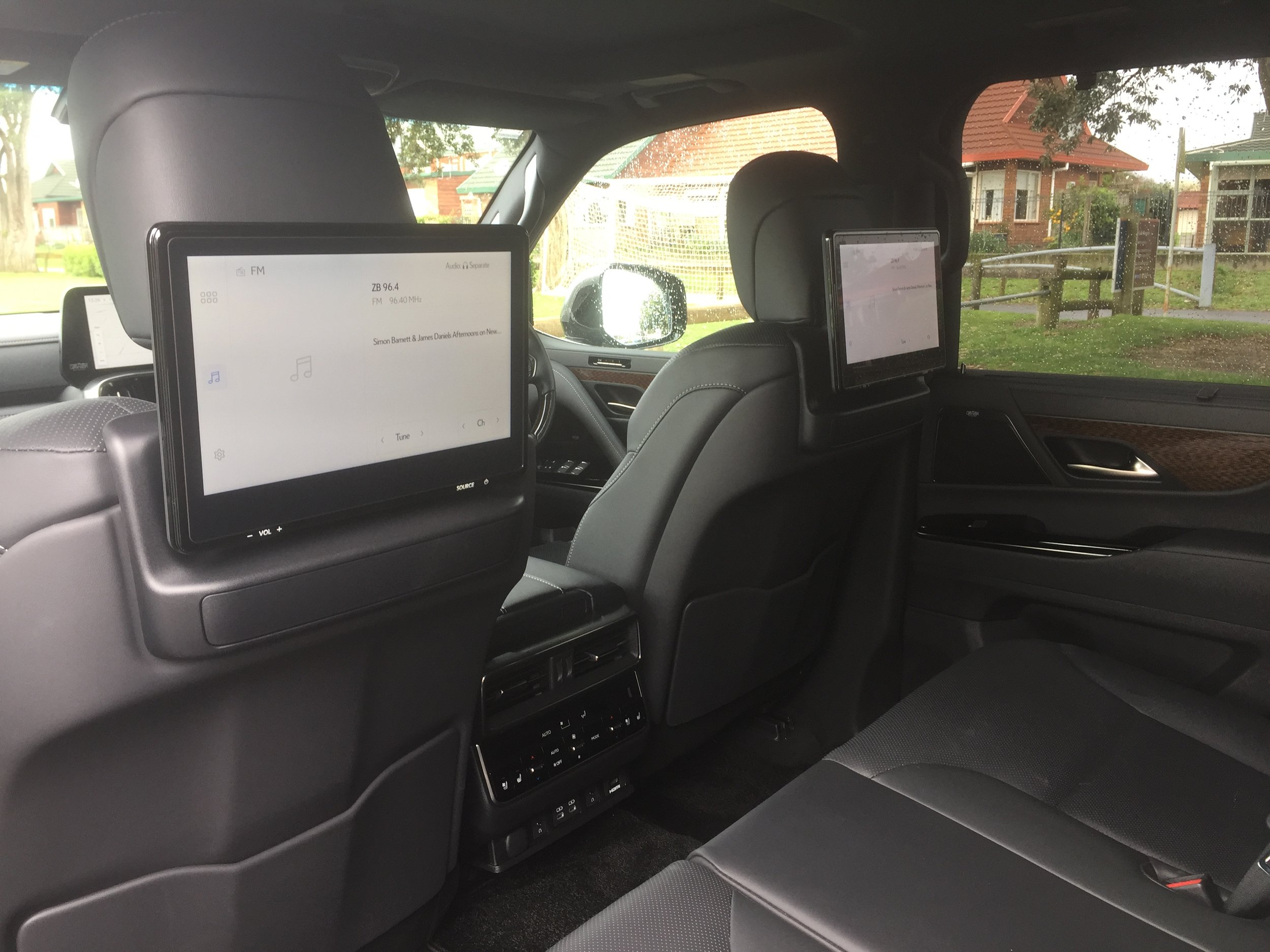Lexus LX500d Limited roadtest review: Big boy among the small fry
/Does this XXL model rate as a catch of the day?
Price: $175,900
Powertrain and economy: 3.3-litre twin turbocharged V6 diesel, 227kW/700Nm, 10-speed automatic, full-time 4WD, combined economy 10.2 L/100km (3P-WLTP test), CO2 268g/km.
Vital statistics: 5100mm long, 1990mm wide, 1895mm high, 2850mm wheelbase, luggage capacity 1100 litres, 22-inch alloy wheels
We like: Sheer luxury; heaps of interior room; massive torque; off-road capable.
Not so much: Visually intrusive grille; CO2 count an issue.
HERE’S the biggest boy checking out the tiniest fellows, both facing significant environmental challenges.
The largest Lexus, the LX500d, is a monster. It’s more than five metres long and close to two metres in height and width, and its latest iteration has such a large grille that when cruising down a road it looks a bit like a whale chasing krill.
Krill. That’s a Norwegian word that translates to ‘small fry of fish’. And talking about small fry, New Zealand is about to experience the annual springtime upstream migration of whitebait, which are the juveniles of five galaxiid species of fish that live as adults in our rivers and streams.
Traditionally, when the whitebait start their upstream runs, many people gather to catch them. Quite the industry has developed to catch and sell the delicious little fish, which can fetch well over $100 a kilogram.
This year environmental authorities have delayed and shortened the whitebait season. Instead of starting on August 15 and running through to November 30, this year it begins on September 1 and wraps up at the end of October. This to reduce fishing pressure on the whitebait species, so their sustainability can be improved.
But preparations for the coming season have no doubt started, making it worthwhile to use a LX500d Limited to pay a visit to the North Island’s whitebaiting hotspot to check out how things are going. And to enjoy a whitebait fritter.
Mokau is a little settlement at the mouth of the Mokau River, north of New Plymouth. Each year thousands of kilograms of whitebait are lifted out of the river, much of it via the more than 600 whitebaiting stands dotted cheek by jowl along the Mokau’s lower banks.
Mokau’s Whitebait Inn is almost as famous as the river for the plate-sized whitebait fritters it serves. It’s become almost a tradition for passing motorists to order a fritter to slap between two slices of white bread and enjoy. To meet that demand the business goes through at least a tonne of the fish a year. That’s a lot of what is an increasingly rare little fish due to the fishing pressure it is facing.
Also rare is the Lexus LX500d. Its price of $175,900 plus a $4715 Clean Car fee keeps it rather exclusive in the first place. Supply is also heavily restricted due to a combination of international demand and a variety of Covid-related issues. On top of all this, as MotoringNZ recently reported, Lexus NZ has cut back on how many it intends to import due to the impact the LX’s 268g/km CO2 emissions count has on the emissions average of the entire Lexus fleet.
What all this means is that if a customer decides to purchase an LX500d in either its Limited or F-Sport guises, there will be a wait of at least 12 months.
In this age of increasing environmental awareness, the good news surrounding this new LX is that it is a totally re-designed vehicle built on Toyota’s latest TNGA GA-F platform designed for full-sized body on frame vehicles, and it is powered by a more fuel efficient and cleaner V6 engine that replaces the former model’s V8.
But despite that the CO2 count is still high, and that raises the big red flag as to whether it remains acceptable for motorist to buy any product with such high levels of exhaust emissions. I think yes – in the case of this LX500d it is an important member of the Lexus fleet that continues to meet the requirements of deep-pocketed customers who desire something that’s big, luxurious, capable, and which can tow anything.
These customers do get financially pinged by having to pay the Clean Car fee, but if they are prepared for that to happen, then so be it.
Now that that’s out of the way, maybe it is time for this review to celebrate the Lexus LX500d for what it is – a very big, powerful, American-style, uber-luxurious SUV. Truth be told it doesn’t really suit New Zealand motoring conditions, especially in urban areas where streets can be very narrow, but for all that it is a wonderful vehicle to experience.
Heaven only knows how many on-board computers are on this Lexus, because it does just about everything automatically, right down to the rear-view mirror which isn’t a mirror at all but a rear camera view via a lens located somewhere at the back of the vehicle.
It is also a superbly solid drive. Built on that new platform, and featuring an adaptive variable suspension system with active height control, this full-time four-wheel drive vehicle feels capable of taking on very tough terrain thanks to a wealth of off-roading features including Multi-Terrain Select and Crawl Control.
I didn’t have the nerve to get into the really rough stuff. The Limited’s 22-inch forged multi-spoke alloys are the biggest yet on any Lexus, and I wasn’t prepared to damage them. So the ‘rough’ driving was confined to touring along unsealed roading alongside the Mokau River to check out the hundreds of whitebaiting stands.
It wasn’t a particularly difficult task, and LX500d did the job with ridiculous ease. A major feature of this latest model is that the previous version’s 4.5-litre turbocharged V8 diesel has been replaced with a 3.3-litre twin-turbocharged V6 diesel that is more powerful despite its smaller cubic capacity. This time around the vehicle has 227kW of power and an enormous 700Nm of torque from just 1600rpm, which was easily enough for anything I was prepared to subject the Lexus to.
I do think though that if I was going to buy a large vehicle for its off-road prowess, I’d opt for the LX500d Limited’s Toyota equivalent, the Land Cruiser 300 Series VX Limited is $34,000 less expensive.
That’s because despite the Lexus’ obvious offroad credentials, it is more suited to a tarmac-dominated motoring environment that can showcase its comfort and luxury.
In that regard, the LX500d is a very impressive vehicle. Its interior design is based on the so-called ‘Tazuna’ cockpit concept first used in the smaller Lexus NX. The word translates to reins of a horse, and the concept is all about helping the driver focus on driving rather than anything else.
Maybe that’s why, for instance, that rear-vision mirror uses a camera rather than simply a view through the back window – it prevents the driver being districted by back-seat passengers.
Obviously the interior is spacious, offering three rows of seats in the Limited. And with the third row folded down, there’s so much cargo room at the back that I once had to crawl inside to access some cargo that was hard up against the back of the second row of seats.
Up front, there’s an extremely wide centre console between the front seats. The front seats are heated and ventilated, with a driver’s seat power adjustable no less than 14 ways. Even the passenger seat power adjusts 12 ways. The second row of seats also has a powered tumble mechanism, while the third row has powered recline and folding.
Air conditioning is a four-zone system, the audio is a 25-speaker Mark Levinson, and there’s Apple CarPlay and Android Auto connectivity. In the Limited model there’s a rear seat entertainment system featuring a pair of 11.6-inch full HD touch screens. The Limited also has a total of six USB ports throughout the vehicle, as well as three power outlets.
What all helps provide is a very luxurious drive in a big vehicle with its wealth of ride, handling and safety aids.
That new V6 helps. Despite its smaller cubic capacity when compared to the old V8, it develops 170Nm more and you can really feel this in the way it lopes along with engine revolutions remaining low. It’s new 10-speed automatic helps in that regard.
However as is usually the case with published fuel economy figures, and despite the fact that during my week with the LX500d I revelled in its relaxed and cruisy characteristics, I couldn’t get anywhere near its stated 10.2 L/100km. My figure was 12.1 L/100km, which I suppose was still pretty good for a big SUV with its kerb weight of around 2.6 tonnes.
Lexus New Zealand claims the LX500d is all about being able to go just about anywhere in luxury. I’d totally agree with that. It presents a very comfortable journey for those aboard, even if its environmental impact remains a little too high.





















